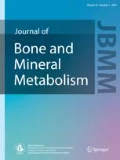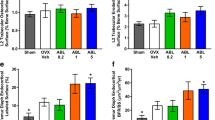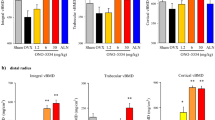Abstract
Bazedoxifene (BZA) is a novel selective estrogen receptor modulator in clinical development for the prevention and treatment of postmenopausal osteoporosis. This preclinical study evaluated the efficacy and safety of BZA in preventing ovariectomy (OVX)-induced bone loss in aged cynomolgus monkeys. Animals (18 per group) underwent OVX and were administered BZA (0.2, 0.5, 1, 5, or 25 mg/kg/day) or vehicle, or were sham-operated and administered vehicle, by daily oral gavage for 18 months. Biochemical markers of bone turnover were assessed at 6, 12, and 18 months, along with bone densitometry using dual energy X-ray absorptiometry and peripheral quantitative computed tomography. Animals were killed after 18 months. Uterine and pituitary weights were determined, and histomorphometric and biomechanical measurements were performed. OVX vehicle controls showed increases in bone turnover associated with cancellous and cortical bone osteopenia (in vivo), and slight decreases (not statistically significant) in biomechanical strength parameters at the lumbar spine and femoral neck. BZA partially preserved cortical and cancellous bone mass by preventing the OVX-induced increases in bone turnover. Although the response was often similar among BZA-treated groups, the strongest efficacy was generally seen at 25 mg/kg/day. Treatment with BZA did not adversely affect measures of bone strength and was well tolerated; there was no evidence of uterotrophic activity, mammary tissue was unaffected, and there were no adverse effects on plasma lipids. Treatment of ovariectomized animals with BZA partially prevented changes in bone remodeling that correlated with increases in bone mineral density, while maintaining bone strength and a favorable safety profile.




Similar content being viewed by others
References
Fast Facts on Osteoporosis. National Osteoporosis Foundation. http://www.nof.org/node/40. Accessed 28 Feb 2014
Burge R, Dawson-Hughes B, Solomon DH, Wong JB, King A, Tosteson A (2007) Incidence and economic burden of osteoporosis-related fractures in the United States, 2005–2025. J Bone Miner Res 22:465–475
Atik OS, Gunal I, Korkusuz F (2006) Burden of osteoporosis. Clin Orthop Relat Res 443:19–24
Ioannidis G, Papaioannou A, Hopman WM, Akhtar-Danesh N, Anastassiades T, Pickard L, Kennedy CC, Prior JC, Olszynski WP, Davison KS, Goltzman D, Thabane L, Gafni A, Papadimitropoulos EA, Brown JP, Josse RG, Hanley DA, Adachi JD (2009) Relation between fractures and mortality: results from the Canadian Multicentre Osteoporosis Study. CMAJ 181:265–271
Salaffi F, Cimmino MA, Malavolta N, Carotti M, Di ML, Scendoni P, Grassi W (2007) The burden of prevalent fractures on health-related quality of life in postmenopausal women with osteoporosis: the IMOF study. J Rheumatol 34:1551–1560
Management of osteoporosis in postmenopausal women (2010) 2010 position statement of The North American Menopause Society. Menopause 17:25–54
Deroo BJ, Korach KS (2006) Estrogen receptors and human disease. J Clin Invest 116:561–570
Komm BS, Lyttle CR (2001) Developing a SERM: stringent preclinical selection criteria leading to an acceptable candidate (WAY-140424) for clinical evaluation. Ann N Y Acad Sci 949:317–326
Komm BS, Kharode YP, Bodine PV, Harris HA, Miller CP, Lyttle CR (2005) Bazedoxifene acetate: a selective estrogen receptor modulator with improved selectivity. Endocrinology 146:3999–4008
Miller CP, Collini MD, Tran BD, Harris HA, Kharode YP, Marzolf JT, Moran RA, Henderson RA, Bender RH, Unwalla RJ, Greenberger LM, Yardley JP, Abou-Gharbia MA, Lyttle CR, Komm BS (2001) Design, synthesis, and preclinical characterization of novel, highly selective indole estrogens. J Med Chem 44:1654–1657
Lewis-Wambi JS, Kim H, Curpan R, Grigg R, Sarker MA, Jordan VC (2011) The selective estrogen receptor modulator bazedoxifene inhibits hormone-independent breast cancer cell growth and down-regulates estrogen receptor alpha and cyclin D1. Mol Pharmacol 80:610–620
Archer DF (2004) Role of the nonhuman primate for research related to women’s health. ILAR J 45:212–219
Bellino FL, Wise PM (2003) Nonhuman primate models of menopause workshop. Biol Reprod 68:10–18
Brommage R (2001) Perspectives on using nonhuman primates to understand the etiology and treatment of postmenopausal osteoporosis. J Musculoskelet Neuronal Interact 1:307–325
Smith SY, Jolette J, Turner CH (2009) Skeletal health: primate model of postmenopausal osteoporosis. Am J Primatol 71:752–765
Ronkin S, Northington R, Baracat E, Nunes MG, Archer DF, Constantine G, Pickar JH (2005) Endometrial effects of bazedoxifene acetate, a novel selective estrogen receptor modulator, in postmenopausal women. Obstet Gynecol 105:1397–1404
Guidelines for preclinical and clinical evaluation of agents used in the prevention or treatment of postmenopausal osteoporosis. Division of Metabolic and Endocrine Drug Products; Food and Drug Administration. http://www.fda.gov. Accessed 28 Feb 2014
Lundon K, Grynpas M (1993) The long-term effect of ovariectomy on the quality and quantity of cortical bone in the young cynomolgus monkey: a comparison of density fractionation and histomorphometric techniques. Bone 14:389–395
Turner CH, Burr DB (1993) Basic biomechanical measurements of bone: a tutorial. Bone 14:595–608
Parfitt AM, Drezner MK, Glorieux FH, Kanis JA, Malluche H, Meunier PJ, Ott SM, Recker RR (1987) Bone histomorphometry: standardization of nomenclature, symbols, and units. Report of the ASBMR Histomorphometry Nomenclature Committee. J Bone Miner Res 2:595–610
Hotchkiss CE, Stavisky R, Nowak J, Brommage R, Lees CJ, Kaplan J (2001) Levormeloxifene prevents increased bone turnover and vertebral bone loss following ovariectomy in cynomolgus monkeys. Bone 29:7–15
Mashiba T, Turner CH, Hirano T, Forwood MR, Johnston CC, Burr DB (2001) Effects of suppressed bone turnover by bisphosphonates on microdamage accumulation and biomechanical properties in clinically relevant skeletal sites in beagles. Bone 28:524–531
Allen MR, Iwata K, Phipps R, Burr DB (2006) Alterations in canine vertebral bone turnover, microdamage accumulation, and biomechanical properties following 1-year treatment with clinical treatment doses of risedronate or alendronate. Bone 39:872–879
Mashiba T, Hirano T, Turner CH, Forwood MR, Johnston CC, Burr DB (2000) Suppressed bone turnover by bisphosphonates increases microdamage accumulation and reduces some biomechanical properties in dog rib. J Bone Miner Res 15:613–620
Seeman E (2008) Structural basis of growth-related gain and age-related loss of bone strength. Rheumatology (Oxford) 47 Suppl 4:iv2–iv8
Lewiecki EM, Watts NB (2008) Assessing response to osteoporosis therapy. Osteoporos Int 19:1363–1368
Lees CJ, Register TC, Turner CH, Wang T, Stancill M, Jerome CP (2002) Effects of raloxifene on bone density, biomarkers, and histomorphometric and biomechanical measures in ovariectomized cynomolgus monkeys. Menopause 9:320–328
Ott SM, Oleksik A, Lu Y, Harper K, Lips P (2002) Bone histomorphometric and biochemical marker results of a 2-year placebo-controlled trial of raloxifene in postmenopausal women. J Bone Miner Res 17:341–348
Stepan JJ, Alenfeld F, Boivin G, Feyen JH, Lakatos P (2003) Mechanisms of action of antiresorptive therapies of postmenopausal osteoporosis. Endocr Regul 37:225–238
Fontana A, Delmas PD (2003) Selective estrogen receptors modulators in the prevention and treatment of postmenopausal osteoporosis. Endocrinol Metab Clin North Am 32:219–232
Allen MR, Iwata K, Sato M, Burr DB (2006) Raloxifene enhances vertebral mechanical properties independent of bone density. Bone 39:1130–1135
Allen MR, Hogan HA, Hobbs WA, Koivuniemi AS, Koivuniemi MC, Burr DB (2007) Raloxifene enhances material-level mechanical properties of femoral cortical and trabecular bone. Endocrinology 148:3908–3913
Lees C, Shen V, Brommage R (2007) Effects of lasofoxifene on bone in surgically postmenopausal cynomolgus monkeys. Menopause 14:97–105
Vrablik M, Fait T, Kovar J, Poledne R, Ceska R (2008) Oral but not transdermal estrogen replacement therapy changes the composition of plasma lipoproteins. Metabolism 57:1088–1092
Clarkson TB, Anthony MS, Jerome CP (1998) Lack of effect of raloxifene on coronary artery atherosclerosis of postmenopausal monkeys. J Clin Endocrinol Metab 83:721–726
Christiansen C, Chesnut CH III, Adachi JD, Brown JP, Fernandes CE, Kung AW, Palacios S, Levine AB, Chines AA, Constantine GD (2010) Safety of bazedoxifene in a randomized, double-blind, placebo- and active-controlled Phase 3 study of postmenopausal women with osteoporosis. BMC Musculoskelet Disord 11:130
Pickar JH, MacNeil T, Ohleth K (2010) SERMs: progress and future perspectives. Maturitas 67:129–138
Pinkerton JV, Goldstein SR (2010) Endometrial safety: a key hurdle for selective estrogen receptor modulators in development. Menopause 17:642–653
Cummings SR, Eckert S, Krueger KA, Grady D, Powles TJ, Cauley JA, Norton L, Nickelsen T, Bjarnason NH, Morrow M, Lippman ME, Black D, Glusman JE, Costa A, Jordan VC (1999) The effect of raloxifene on risk of breast cancer in postmenopausal women: results from the MORE randomized trial. Multiple Outcomes of Raloxifene Evaluation. JAMA 281:2189–2197
Pinkerton JV, Archer DF, Utian WH, Menegoci JC, Levine AB, Chines AA, Constantine GD (2009) Bazedoxifene effects on the reproductive tract in postmenopausal women at risk for osteoporosis. Menopause 16:1102–1108
Archer DF, Pinkerton JV, Utian WH, Menegoci JC, de Villiers TJ, Yuen CK, Levine AB, Chines AA, Constantine GD (2009) Bazedoxifene, a selective estrogen receptor modulator: effects on the endometrium, ovaries, and breast from a randomized controlled trial in osteoporotic postmenopausal women. Menopause 16:1109–1115
Miller PD, Chines AA, Christiansen C, Hoeck HC, Kendler DL, Lewiecki EM, Woodson G, Levine AB, Constantine G, Delmas PD (2008) Effects of bazedoxifene on BMD and bone turnover in postmenopausal women: 2-yr results of a randomized, double-blind, placebo-, and active-controlled study. J Bone Miner Res 23:525–535
Silverman SL, Christiansen C, Genant HK, Vukicevic S, Zanchetta JR, de Villiers TJ, Constantine GD, Chines AA (2008) Efficacy of bazedoxifene in reducing new vertebral fracture risk in postmenopausal women with osteoporosis: results from a 3-year, randomized, placebo-, and active-controlled clinical trial. J Bone Miner Res 23:1923–1934
Acknowledgments
This study was sponsored by Wyeth Research, which was acquired by Pfizer Inc in October 2009. We are grateful to the excellent technical expertise of the Imaging, Histomorphometry, and Biomechanics teams at Charles River Laboratories, who were paid contractors to Wyeth in connection with study execution. Medical writing support for this manuscript was provided by Katie Gersh, PhD, of MedErgy and Linda Romagnano, PhD, of Peloton Advantage and was funded by Pfizer.
Conflict of interest
B. Komm is an employee of Pfizer Inc (previously Wyeth Research), Collegeville, PA, USA. All other authors are employees of Charles River Laboratories who were paid contractors to Wyeth in connection with study execution. They report no other relevant conflicts of interest.
Author information
Authors and Affiliations
Corresponding author
About this article
Cite this article
Smith, S.Y., Jolette, J., Chouinard, L. et al. The effects of bazedoxifene in the ovariectomized aged cynomolgus monkey. J Bone Miner Metab 33, 161–172 (2015). https://doi.org/10.1007/s00774-014-0580-z
Received:
Accepted:
Published:
Issue Date:
DOI: https://doi.org/10.1007/s00774-014-0580-z




